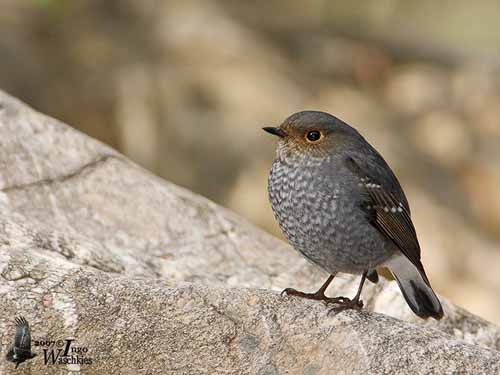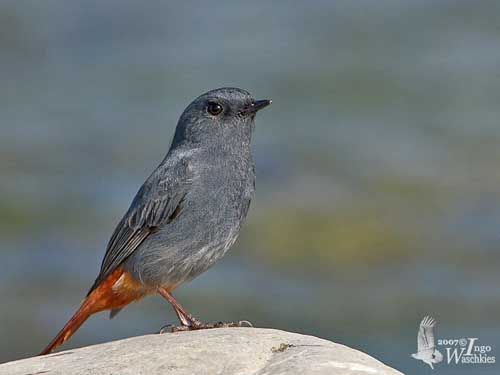
Fr: Nymphée fuligineuse
All : Wasserrötel
Esp: Colirrojo Fuliginoso
Ital: Codirosso fuligginoso
Nd: Waterroodstaart
Sd: Forsrödstjärt
Photographer:
Ingo Waschkies
Bird Photography
Text by Nicole Bouglouan
Sources:
HANDBOOK OF THE BIRDS OF THE WORLD Vol 10 by Josep del Hoyo-Andrew Elliott-David Christie - Lynx Edicions - ISBN: 8487334725
A Field Guide to the Birds of South-East Asia by Craig Robson. New Holland Publishers. ISBN: 9781780090498
BirdLife International (BirdLife International)
Taiwan’s Ecological Conservation
Plumbeous Water-redstart
Phoenicurus (Rhyacornis) fuliginosa
Passeriforme Order – Muscicapidae Family
BIOMETRICS:
Length: 12-13 cm
Weight: 13-23 gr
DESCRIPTION:
The Plumbeous Water-redstart belongs to the genus Rhyacornis with a second species, the Luzon Water-redstart (Rhyacornis bicolor). Both species are closely associated to watercourses where they find their preys.
The adult male has slaty-blue to dark lead-coloured plumage overall, except the rufous-chestnut uppertail and undertail-coverts, vent and tail. The lower belly is whitish-grey. The flight feathers can be darker, mostly bluish-black.
The bill is black. The eyes are dark brown. Legs and feet are flesh-coloured.

The adult female has slaty-grey upperparts, white rump and bases of outer rectrices. Wings are browner with pale edges forming two white-spotted wingbars. The tail is brown too, with white outermost rectrices, and white bases to the following ones.
Underparts are whitish, heavily barred grey involving scaled pattern. Undertail-coverts and vent are white.
The head is slaty-grey with chestnut tinge on forehead, lores and ear-coverts.
The bill is black. The eyes are dark brown surrounded by narrow whitish eyering. Legs and feet are pinkish-brown.
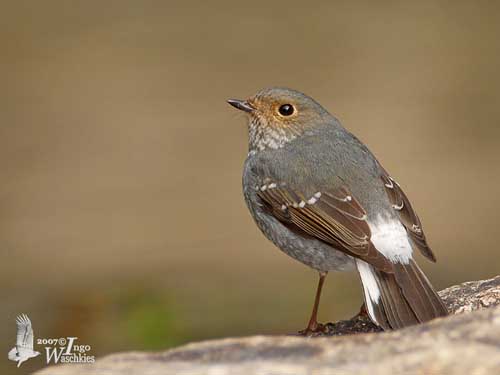
The juvenile resembles female but it is browner overall, with white spots on upperparts.
We can find two subspecies:
R.f. fuliginosa (here described and displayed). It is found in E Afghanistan and Himalayas, NE and E China, NW Thailand, Indochina and Hainan Island.
R.f. affinis occurs in Taiwan. In this race, the male is similar to that of nominate race, but the female is duller grey above and less barred below, giving darker effect overall.
VOICE: SOUNDS BY XENO-CANTO
The Plumbeous Water-redstart male usually sings from perch, a rock in the middle of a stream, or while flying gracefully from rock to rock.
It utters a thin, rapidly repeated 4-7 times “streee-treee-tree-treeeh” often rising in pitch.
The call is a short, sharp, strident whistled “peet-peet” often combined with clicks “tk tk”.
HABITAT:
The Plumbeous Water-redstart frequents rocky rivers and streams both inside and outside forest. It can be found from narrow watercourses to broad mountain torrents, in waterfalls and nearby wet areas.
This species breeds at high elevation, globally between 1000 and 4000 metres, and winters down to adjacent lowlands.
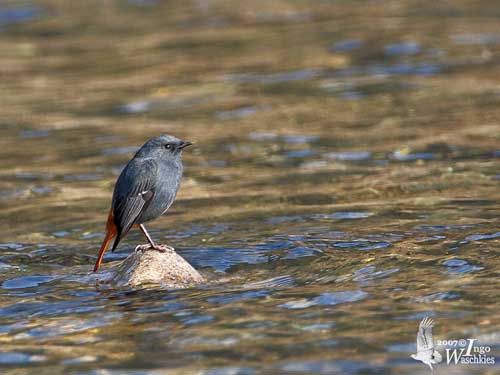
RANGE:
See above in “subspecies”
BEHAVIOUR:
The Plumbeous Water-redstart feeds primarily on wide variety of insects, and may occasionally take berries and seeds. It performs short flycatching sallies from perches such as rocks in the water, or branches hanging over the stream. It also snatches preys from the water surface, or walks along the water edge, and even wades in shallows.
While foraging and feeding, it continuously opens and shuts the tail, and moves it up and down.
During the breeding season, and probably all year round for this resident bird, the territory is established along a stream over 400-900 metres. This species can be territorial and aggressive, chasing away all the birds entering its area, including larger birds. Fights may occur sometimes. The male stands up its body on its legs while singing, then, it lowers the upper body and erects it again several times.
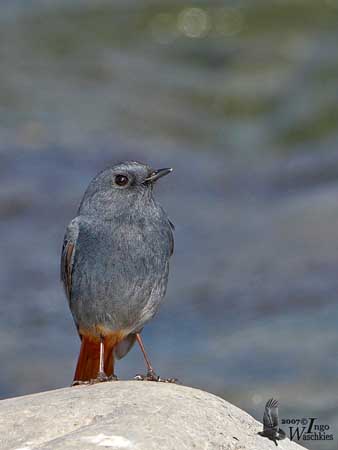
Courtship displays by male enhance the chestnut colour of the tail. When landing, it dips and flicks its tail in rapid scissors-motion, involving a conspicuous visual signal, as well towards female as intruders. It sings loudly, usually from perches.
This species is resident in its range, but it may perform altitudinal movements during winter when breeding at high elevation.
FLIGHT:
The Plumbeous Water-redstart performs flycatching when hunting, and graceful short flights between several perches over the streams.
REPRODUCTION:
The breeding season varies according to the range, but mainly occurs between March and July. This species usually produces two broods.
The nest of the Plumbeous Water-redstart is a neat cup placed in cavity or hole in rock or bridge, or on side branch in tree-stump, on ledge covered with vegetation but almost always near water.
The deep cup is made with rootlets, grasses, leaves and moss. The inner cup is lined with fine rootlets, plants fibres, wool and hair.
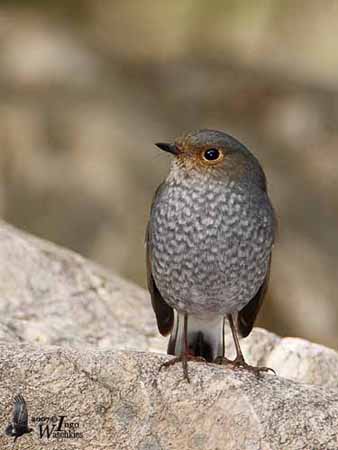
The female lays 3-5 pale greenish or stone-coloured eggs, with dense small darker markings. Incubation is by female but chicks are fed by both parents.
The nest is rarely parasitized by the Common Cuckoo.
DIET:
The Plumbeous Water-redstart feeds primarily on numerous insects and their eggs, such as coleopterans, lepidopterans, dipterans, hymenopterans, orthopterans, Odonata and hemipterans. Spiders are taken too.
It may occasionally consume berries, seeds and leaves.
PROTECTION / THREATS / STATUS:
The Plumbeous Water-redstart is common to fairly common throughout its range.
This species is not currently threatened.
